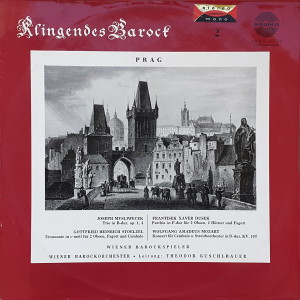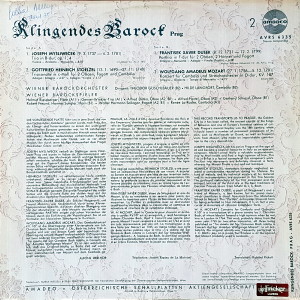 |
1 LP -
Amadeo AVRS 6335
|
 |
|
| PRAG -
Klingendes Barock - 2 |
|
|
|
|
|
|
|
| Joseph
Mysliwecek (9.3.1737 - 4.2.1781) |
|
|
|
| 1. Trio in B-dur,
Op. 1, 4 |
|
8' 55" |
A1
|
| - Vivace ·
Andante · Menuetto |
|
|
|
|
|
|
|
Gottfried
Heinrich Stoelzel (13.1.1690 -
27.11.1749)
|
|
|
|
| 2. Triosonate in
c-moll für 2 Oboen, Fagott und
Cembalo |
|
10' 39" |
A2 |
| -
Adagio/Allegro |
6' 27" |
|
|
| -
Adagio/Vivace |
4' 12" |
|
|
|
|
|
|
František Xaver
Dusek (8.12.1731 - 12.21799)
|
|
|
|
| 3. Parthia in
F-dur für 2 Oboen, 2
Hörner und Fagott |
|
6' 28" |
B1 |
| - Allegro ·
Menuetto · Adagio · Finale
(Presto) |
|
|
|
|
|
|
|
Wolfgang Amadeus Mozart
(27.1.1756 - 5.12.1791)
|
|
|
|
| 4.
Konzert für Cembalo und
Streichorchester in D-dur, Kv. 107 |
|
14' 15" |
B1 |
| -
Allegro · Andante · Tempo di
Menuetto |
|
|
|
|
|
|
|
| WIENER
BAROCKSPIELER |
Hilde
Langfort, Cembalo (B2)
|
|
| -
Helmut Riessberger, Flöte
(A1) |
WIENER
BAROCKORCHESTER / Theodor
Guschlbauer, Leitung (B2) |
|
| -
Genser Winkler-Trio, (A1) |
|
|
| -
Alfred Dutka, Oboe
(A2,B1) |
|
|
| -
Alfred Hertel, Oboe (A2) |
|
|
| -
Gerhard Schiessl, Oboe
(B1) |
|
|
| -
Robert Freund, Hannes
Sungler, Horn (B1) |
|
|
| -
Walter Hermann Sallagar, Fagott
(A2,B1) |
|
|
| -
Renée La Roche, Cembalo
(A2) |
|
|
|
|
|
|
Luogo
e data di registrazione |
|
Casino
Baumgartner, Vienna (Austria) -
settembre 1964 |
|
|
Registrazione:
live / studio |
|
studio |
|
|
Edizione LP |
|
AMADEO
- AVRS 6335 - (1 lp) - durata 40'
17" - (p) 1966 - Analogico |
|
|
Altre edizioni
LP
|
|
MUSICAL
HERITAGE SOCIETY - MHS 524 - (1
lp) - (1)
MUSICAL
HERITAGE SOCIETY - MHS 581 - (1
lp) - (2)
MUSICAL
HERITAGE SOCIETY - MHS 528 -
(1 lp) - (3)
MUSICAL
HERITAGE SOCIETY - MHS 619 -
(1 lp) - (4)
|
|
|
Prima Edizione
CD |
|
- |
|
|
Note |
|
Stereo
compatibile
|
|
|
|
|
THIS
RECORD TRANSPORTS US
TO PRAGUE, the
Golden City as it
has been called, the
ancient capital of
the Kings of Bohemia
and one of Europe's
foremost centres of
culture. Prague's
musical heyday was
the 18th
century, when it
could boast a number
of prominent
composers of its
own, such as
Mysliwecek or Dusek,
as well as frequent
visits from Mozart,
who made an
imperishable
contribution to the
city's musical life.
JOSEPH MYSLIWECEK
left his native
Prague at the age of
26 and became a
popular favourite in
Italy
as an operatic
composer. Mozart
owed many a valuable
acquaintance-ship to
Mysliwecek and had a
high opinion of him.
This Trio in B flat
is a typical example
of this composer`s
work. The first two
movements are
definitely classical
in form, whereas the
Minuet Finale is
out-and-out baroque.
HEINRICH STOELZEL,
nowadays curiously
neglected, enioyeol
a considerable
reputation during
his lifetime. His
fund of melody, and
his technical
mastery of his
material and its
instrumentation, are
apparent in this
Trio Sonata. The
profound melancholy
of the first
movement and the
tranquil lyricism of
the third are in the
best traditions of
German Passion music
from Schütz
to J. S. Bach.
FRANTISEK
XAVER DUSEK, a pupil
of Wagenseil's and a
friend of Mozart’s,
is best known for
his piano music,
which constitutes a
direct transition
from the Mannheim
School to Mozart.
This "Parthia"
anticipates
classical form by
being extended to
four movements. It
is in fact a
precursor in
miniature of
classical symphonic
form.
W. A. MOZART's
Concerto for Cembalo
and Orchestra K 107
is a transcription
of a piano sonata by
J. Christian Bach,
of whom Mozart
formed a high
opinion when he met
him in London in
1764. The work
probably dates from
the same year 1765
as two other
concertos, all three
being published as
"Tre sonate del Sgr.
Giovanni Bach
ridotte in Concerti
dal Sgr. Amadeo
Wolfgango Mozart". In
all probability the
original sonata was
frequently performed
in J. C. Bach's day
on a piano, but
Einstein is of the
opinion that Mozart
probably used a
cembalo.
Alfons
Übelhör
(Translation:
Richard Rickett)
|
|

